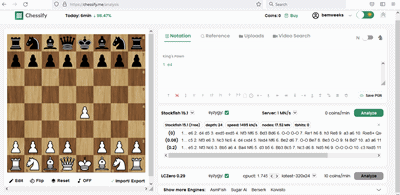Chessify Progress Report
A month ago, in Chessify Setup (December 2022), I wrote,
I set up a Chessify account, received some free time on their service, and started a new game on the LSS server, where engine use is generally allowed. I'll report on my progress in a future post.
This post is that report. I had White in the first LSS game, and after starting a Caro Kann (1.e4 c6 2.d4 d5), decided to play a move that I have always wanted to try: 3.f3, known for some obscure reason as the 'Fantasy Variation'. After six moves, my opponent disappeared, apparently having quit LSS. I started a new game, chose the highest rated opponent I could find, and received White again. My opponent turned out to be a specialist in a little-played variant of the Ruy Lopez, and had played 15 games with it on LSS. This gave me the chance to use Chessify to analyze the moves of his previous games. We have reached move 10 and I expect to follow his previous games for another few moves.
The two LSS games have given me sufficient opportunity to make an initial evaluation of Chessify. Following is a screen capture showing the user interface (GUI) after 1.e4.

The tool fits well with my method of analyzing correspondence games. I normally use three PGN copies of each game. I use one copy for my notes (the foreground copy). For the traditional start position, the opening notes include references to theory. I use another copy for engine analysis (the background copy) and I use a third copy for the moves actually played in the game (the official copy). Chessify replaces the copy for engine analysis.
I tried to keep a copy of the PGN within Chessify to carry over from one analysis session to another. That would be important if I were playing two or more games at the same time. I quickly realized that I didn't understand how it worked and decided to use the 'Import FEN' feature instead. That means I set up the current position of interest at the beginning of a session by copying the FEN string from the software that manages the foreground copy (SCID), and analyze from that point. I'll come back to Chessify PGN functionality if and when I need it.
Over the past month I've noted a few issues. The first arose from the email that confirmed my signup. It said,
Click the button below to verify your email address and receive 200 coins for free to try Chessify's up to 1,000,000 KN/s speed servers.
I never received any coins. A message at the top of the GUI always says, 'Coins : 0'. I also clicked on a free trial offer and received the message:-
Your free trial is on! Until November 23, you will have free access to all our features.
This was on December 21, well after the trial supposedly ended, and I still have no idea what 'free access' involves. Another problem is with network latency. I sometimes clicked 'Analyze' or 'Stop' engine evaluation and waited up to a minute for a response. Not sure if there was a problem, I then clicked a second time and triggered some buggy behavior that required a GUI reset to eliminate. I have other examples of some bugginess, but for now I'll just attribute it to the learning curve. A few other items worth mentioning are:-
- No online help
- No copying engine analysis to clipboard
- No chess960 support
None of the issues I've mentioned are blocking problems. I can live with all of them because I really like the functionality provided by the service.
I also considered subscribing; the info is here: Chessify Subscription Plans and Coins. The difference between the 'Free' plan and the 'Amateur' plan is currently about 80 USD per year. As much as I would like to subscribe, I don't see much functional difference between the two plans.
I'll continue to evaluate the service and perhaps learn why it's worth a subscription. If I discover anything important that I've overlooked to date, I'll come back with another post.




No comments:
Post a Comment